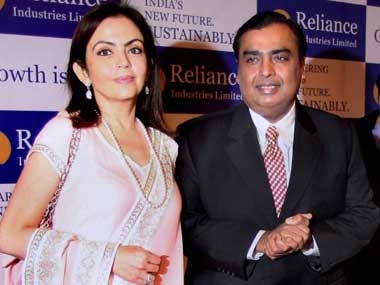What was Mukesh Ambani really trying to tell his shareholders at Thursday’s AGM in Mumbai?
Everyone knows the company has not had a great year. The share price has tanked over the last 12 months (25 percent for Reliance against Sensex’s 11 percent fall), margins are under pressure (refining, petrochem), many key businesses are yet to deliver on their potential (Krishna Godavari gas and retail, for example), and the company seems to be making more money from money than from its main businesses.
When you are hurting, the best way to raise spirits and rally the troops is to avoid focusing on the present, and look instead at the glorious past and point to a rosy future. To moderate shareholder expectations you also have to paint a gloomier current scenario and explain how you are doing better even after this.
Reading between the lines of Ambani’s AGM address, this is precisely what he seems to have done.
[caption id=“attachment_335560” align=“alignleft” width=“380” caption=“Reliance Industries Chairman Mukesh Ambani with wife Nita at the company’s Annual General Meeting in Mumbai on Thursday. Mitesh Bhuvad/PTI”]
 [/caption]
[/caption]
A close read of his speeches at the 2011 AGM and the latest one bring this out in sharp relief. It is clear that when the outlook appeared bullish last year, Ambani had no need to talk about any negatives or make any specific promises on how the company will perform in the future. Now, he needed to.
A year ago, he could let the numbers speak for themselves. Today, in a gloomier world and domestic scenario, he needed to talk of the numbers himself.
Impact Shorts
More ShortsAt the 2011 AGM on 3 June, Ambani was chirpy and noted that “2010 was a sunlit year for the global economy, when growth and optimism returned in ample measure.”
This year he had to look at the glass half empty: “The international business environment has become more challenging today than at any time in modern history.” In effect, don’t blame me if Reliance’s market capitalisation has dropped by more than Rs 80,000 crore over the year despite a Rs 10,400 crore share buyback scheme. We are doing better than the world.
“We have seen two unprecedented economic shocks in the last five years with low growth and recession-like conditions in most major economies…In spite of these adverse conditions, Reliance has grown stronger by expanding its asset base and significantly improving its financial position.” Translated, that means, ‘See, I’m not down even with these headwinds.’
Reliance’s unique paradox is that its profitability depends on what happens in India, but a majority of its sales comes from abroad. The Indian government’s policies are pushing him out; the global economy is hurting his margins.
Last year, Ambani saw India’s growth potential as beneficial to Reliance and he said the Indian economy’s high growth trajectory points “to an exponential growth in several sectors across our economy…Reliance is well positioned to remain as one of the engines of India’s growth by its participation in core sectors.”
This year, he noted somberly that “Businesses of Reliance are equally influenced by developments in the Indian economy.” And these developments were?
“High rates of domestic inflation, adverse foreign exchange rate movements, continuing state subsidies for petroleum products and slowdown in rate of economic growth have had an impact on doing business in India.”
Of the factors mentioned, Ambani would surely be concerned most about the “state subsidies for petroleum products” which force him to sell most of his products abroad at lower margins. The unstated message: I would prefer to sell more in India is policies permit.
Talking of the company’s business and financial performance, the figures Ambani gave (and avoiding giving) show what a difference a year has made.
Last year, Ambani talked of “37 percent year on year (growth) for the last 33 years in market capitalisation.” This year, he didn’t talk about market returns at all. He couldn’t.
The numbers he did give told a story of their own. Last year, he said revenues grew 28 percent annually since the company’s IPO 33 years ago. This year, the figure was down to 27 percent - but the drop is more than one percent since it is a compounded average for 34 years this year as against last year’s 33-year average.
Last year, the figure for net profits growth was 30 percent compounded over 33 years; this year it was 29 percent over 34 years. The company’s compounding rate has clearly fallen.
[caption id=“attachment_335574” align=“alignright” width=“380” caption=“RIL Chairman Mukesh Ambani’s mother Kokilaben and son Anant at the company’s AGM in Mumbai on Thursday. Mitesh Bhuvad/PTI”]
 [/caption]
[/caption]
The most interesting number is, of course, the share of the company’s turnover coming from markets abroad: in 2010-11, it was 57 percent exports. In 2011-12, it was 61 percent. Last year exports grew 33 percent; this year 42 percent.
Export grew faster than turnover just when the export markets were slowing down. Reliance may have the world’s biggest single-location refinery, but it is under pressure to find more markets abroad than at home.
This is at the heart of Reliance’s pain. If it could sell more refinery products at market prices in India, its margins would instantly improve.
Thanks to the pain, the growing investor concerns about the company’s future, Reliance has chosen to give more details this year to shareholders than it usually does. Last year it was happy with homilies. This time it gave harder numbers.
In 2011, Ambani was happy to boast that “our refineries had the best margins in the world.” This year, Ambani was more specific, and lowered the boast to this: “Our refining margin, in excess of US$8 per barrel, was among the highest in the world.” But since this is not enough to cheer up the troops, he went further and disclosed that the company is investing in a gasification facility to convert petroleum coke to gas to improve the “Jamnagar complex margins within the next three years” by 30-40 percent.
If one half of his AGM message was to quell doubts among market mavens, another was aimed at the government. Thus, while talking about his KG-D6 gasfield, last year he made references to its “uninterrupted and incident-free operations,” and how the field “remains one of India’s first and only deepwater development and amongst the largest deepwater gasfields in the world.” There was little indication about the coming precipitous drop in output towards the end of the year - just six months away from the AGM. He only said that “significant efforts are underway to comprehend the character and the behaviour of these complex reservoirs…”.
At Thursday’s AGM, Ambani was more forthcoming on the details to give investors hope, and caveats to the government. “We have experienced some disappointment with the (KG gas) reserves and consequently seen production drop below originally estimated quantities.”
Then he raised the hope and the warning. “We are targeting to achieve, in the next three to four years, a total production of 60 mmscmd gas for a sustained period. Government and regulatory approvals are key to achieving this…”.
The “three to four years” is an important element of the promise, since Ambani is hoping that after 2014, gas pricing will be freed from official constraints. Raising gas output after that event make commercial sense. More importantly, last year Ambani gave no guidance on gas production targets or numbers; this time he has made specific promises.
This is apparent in some other sectors, too.
At the 2011 AGM, Ambani was happy to talk about the number of stores and customers walking into Reliance Retail outlets: 1,000 stores, and 2.5 million customers every week.
This year, he said revenues were over Rs 7,600 crore, and promised to take the turnover from retail to Rs 40,000-50,000 crore in three to four years. That’s a five-fold growth - and would be spectacular, if achieved.
On wireless broadband, in both years he was content to make only broad statements of intent and potential, but when it came to the company as a whole, he made very specific promises.
Among them: he will be investing Rs 1,00,000 crore over the next five years. More importantly, he has promised to double operating profits over the same period. This means raising operating profits from around Rs 34,000 crore to Rs 68,000-70,000 crore.
This means 14-15 percent compounded growth in operating profits. He concluded with this sentence: “The journey ahead is…going to be far more exciting and rewarding.” Last year, he merely said that “Tomorrow’s Reliance will also be a much stronger Reliance.”
In the context of the current doubts over the future of Reliance’s growth story, perhaps he needed to give shareholders this additional reassurance.
From a sepia-tinted present, he would like the world to see Reliance’s future with rose-tinted glasses.
Read entire text of Mukesh Ambani’s speech below
Reliance Industries Ltd 070612)